Newark, New Jersey, Hgh State Clinic, Hgh Injections, Hrt Doctors
Newark, New Jersey Blood Testing Facilities
 Represents a LabCorp blood testing facility
Represents a LabCorp blood testing facility Represents a Quest Diagnostics blood testing facility
Represents a Quest Diagnostics blood testing facility
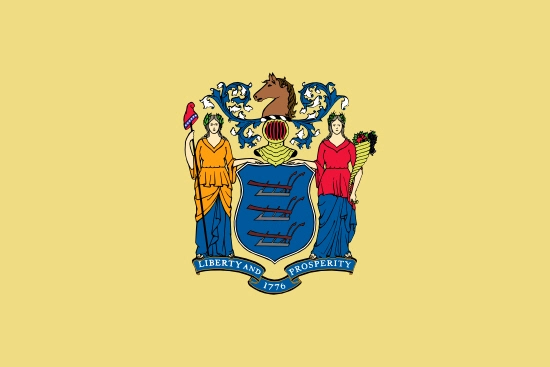
Nearby Labcorp Blood Testing facilities:
- Labcorp Center Distance: 0 m, 92 Ferry St Ste 101, Newark, Essex County, NJ, 7105
- Labcorp Center Distance: 1 m, 393 Central Avenue, Newark, Essex County, NJ, 7103
- Labcorp Center Distance: 3 m, 345 Henry St Ste 104, Orange, Essex County, NJ, 7050
- Labcorp Center Distance: 5 m, 988 Broadway Suite 101, Bayonne, Hudson County, NJ, 7002
- Labcorp Center Distance: 6 m, 2333 Morris Ave Ste A12, Union, Union County, NJ, 7083
- Labcorp Center Distance: 7 m, 240 Port Richmond Ave, Staten Island, Richmond County, NY, 10302
- Labcorp Center Distance: 8 m, 1011 Clifton Ave Ste 2C, Clifton, Passaic County, NJ, 7013
- Labcorp Center Distance: 9 m, 1025 W Saint Georges Ave Ste 1, Linden, Union County, NJ, 7036
- Labcorp Center Distance: 10 m, 1031 Mcbride Ave Ste D-204, Woodland Park, Passaic County, NJ, 7424
- Labcorp Center Distance: 11 m, 31 New Dorp Ln, Staten Island, Richmond County, NY, 10306
- Labcorp Center Distance: 12 m, 313 South Ave Ste 104, Fanwood, Union County, NJ, 7023
- Labcorp Center Distance: 13 m, 4434 Amboy Rd 2Nd Fl, Staten Island, Richmond County, NY, 10312
- Labcorp Center Distance: 14 m, 307 Hamburg Tpke Ste 103, Wayne, Passaic County, NJ, 7470
- Labcorp Center Distance: 15 m, 33-54 83Rd St Ste G-02, Jackson Heights, Queens County, NY, 11372
- Labcorp Center Distance: 16 m, 3219 Us Highway 46 Ste 208, Parsippany, Morris County, NJ, 7054
- Labcorp Center Distance: 17 m, 775 Mountain Blvd. Ste 102, Watchung, Somerset County, NJ, 7069
- Labcorp Center Distance: 18 m, 2839 State Route 10, Morris Plains, Morris County, NJ, 7950
- Labcorp Center Distance: 19 m, 38 Hamburg Tpke, Riverdale, Morris County, NJ, 7457
- Labcorp Center Distance: 20 m, 328 Green Brook Rd Unit D, Green Brook, Somerset County, NJ, 8812
- Labcorp Center Distance: 21 m, 984 N Broadway Ste 301, Yonkers, Westchester County, NY, 10701
- Labcorp Center Distance: 22 m, 1034 N Broadway, Yonkers, Westchester County, NY, 10701
- Labcorp Center Distance: 23 m, 175 Memorial Hwy, New Rochelle, Westchester County, NY, 10801
- Labcorp Center Distance: 24 m, 77 Veronica Ave Ste 101, Somerset, Somerset County, NJ, 8873
- Labcorp Center Distance: 25 m, 2001 Marcus Ave Ste N215, New Hyde Park, Nassau County, NY, 11042
- Labcorp Center Distance: 26 m, 66 Town Centre Suite 310, Succasunna, Other, NJ, 7876
- Labcorp Center Distance: 27 m, 200 E Eckerson Rd Ste 220, New City, Rockland County, NY, 10956
- Labcorp Center Distance: 28 m, 297 Knollwood Rd Ste 102, White Plains, Westchester County, NY, 10607
- Labcorp Center Distance: 29 m, 15 Third St 1St Fl, New City, Rockland County, NY, 10956
- Labcorp Center Distance: 30 m, 105 Raider Blvd Suite 103, Hillsborough, Somerset County, NJ, 8844
- Labcorp Center Distance: 31 m, 1540 Route 202 Ste 6, Pomona, Rockland County, NY, 10970
- Labcorp Center Distance: 32 m, 239 Prospect Plains Rd Ste A102, Monroe Township, Middlesex County, NJ, 8831
- Labcorp Center Distance: 33 m, 3000 Hempstead Tpke 316, Levittown, Nassau County, NY, 11756
- Labcorp Center Distance: 34 m, 254 B Mountain Ave Ste 104, Hackettstown, Warren County, NJ, 7840
- Labcorp Center Distance: 35 m, Viking Village Rt 94 Bldg 3 A, Vernon, Sussex County, NJ, 7462
- Labcorp Center Distance: 36 m, 100 Manetto Hill Rd Ste 309, Plainview, Nassau County, NY, 11803
- Labcorp Center Distance: 38 m, 1 Westcott Dr Ste 201, Flemington, Hunterdon County, NJ, 8822
- Labcorp Center Distance: 39 m, 1290 Summer St Unit 5100, Stamford, Fairfield County, CT, 6902
- Labcorp Center Distance: 40 m, 1985 Crompond Rd Bldg B, Cortlandt Manor, Westchester County, NY, 10567
- Labcorp Center Distance: 41 m, 656 N Wellwood Ave Ste 208A, Lindenhurst, Suffolk County, NY, 11757
- Labcorp Center Distance: 42 m, 1707 Atlantic Ave Ste 1, Manasquan, Monmouth County, NJ, 8736
- Labcorp Center Distance: 43 m, 400 W Main St Ste 304, Babylon, Suffolk County, NY, 11702
- Labcorp Center Distance: 44 m, 101 2Nd Street, Lakewood, Ocean County, NJ, 8701
- Labcorp Center Distance: 45 m, 3 Coates Drive, Goshen, Orange County, NY, 10924
- Labcorp Center Distance: 46 m, 2171 Jericho Tpke. Suite 200, Commack, Suffolk County, NY, 11725
- Labcorp Center Distance: 47 m, 1255 Route 70 Suite 20-S, Lakewood, Ocean County, NJ, 8701
- Labcorp Center Distance: 48 m, 57 E Main St, Bay Shore, Suffolk County, NY, 11706
- Labcorp Center Distance: 49 m, 594 East Main Street, Middletown, Orange County, NY, 10940
- Labcorp Center Distance: 50 m, 150 Islip Ave Ste 9, Islip, Suffolk County, NY, 11751
- Labcorp Center Distance: 51 m, 2 Brooksite Dr, Smithtown, Suffolk County, NY, 11787
- Labcorp Center Distance: 52 m, 411 Coventry Center Dr Bldg400, Phillipsburg, Warren County, NJ, 8865
- Labcorp Center Distance: 53 m, 1592 Route 739, Dingmans Ferry, Pike County, PA, 18328
Nearby Quest Blood Testing facilities:
- Quest Center Distance: 0 m, 24 Commerce St, Newark, Essex County, NJ, 07102-4060
- Quest Center Distance: 5 m, 1896 Morris Ave, Union, Union County, NJ, 07083-3535
- Quest Center Distance: 6 m, 711 E 1St Ave, Roselle, Union County, NJ, 07203-1669
- Quest Center Distance: 7 m, 881 Allwood Rd, Clifton, Passaic County, NJ, 07012-1900
- Quest Center Distance: 8 m, 651 Willowbrook Rd, Staten Island, Richmond County, NY, 10314-6809
- Quest Center Distance: 9 m, 1460 Victory Blvd, Staten Island, Richmond County, NY, 10310-3914
- Quest Center Distance: 10 m, 1361 Hylan Blvd, Staten Island, Richmond County, NY, 10305-1978
- Quest Center Distance: 11 m, 189 Elm St, Westfield, Union County, NJ, 07090-3145
- Quest Center Distance: 12 m, 2627 Hylan Blvd, Staten Island, Richmond County, NY, 10306-4320
- Quest Center Distance: 13 m, 3733 Richmond Ave, Staten Island, Richmond County, NY, 10312-3856
- Quest Center Distance: 14 m, 4855 Hylan Blvd, Staten Island, Richmond County, NY, 10312-6319
- Quest Center Distance: 15 m, 7001 Amboy Rd, Staten Island, Richmond County, NY, 10307-1444
- Quest Center Distance: 16 m, 50 Cherry Hill Rd, Parsippany, Morris County, NJ, 07054-1101
- Quest Center Distance: 17 m, 7010 Austin St, Forest Hills, Queens County, NY, 11375-1021
- Quest Center Distance: 18 m, 37 Mountain Blvd, Warren, Somerset County, NJ, 07059-2622
- Quest Center Distance: 19 m, 16624 Jamaica Ave, Jamaica, Queens County, NY, 11432-5241
- Quest Center Distance: 20 m, 1 Anderson Hill Rd, Bernardsville, Somerset County, NJ, 07924-2320
- Quest Center Distance: 21 m, 970 N Broadway, Yonkers, Westchester County, NY, 10701-1310
- Quest Center Distance: 22 m, 477 Route 10 East, Randolph, Morris County, NJ, 07869-2147
- Quest Center Distance: 23 m, 150 Lockwood Ave, New Rochelle, Westchester County, NY, 10801-4916
- Quest Center Distance: 24 m, 49 Veronica Ave, Somerset, Somerset County, NJ, 08873-6802
- Quest Center Distance: 25 m, 420 Market St, Nanuet, Rockland County, NY, 10954-2744
- Quest Center Distance: 26 m, Indian Rock Shopping Center, Suffern, Rockland County, NY, 10901-4822
- Quest Center Distance: 27 m, 165 North Village Ave, Rockville Centre, Nassau County, NY, 11570-3701
- Quest Center Distance: 28 m, 280 Dobbs Ferry Rd, White Plains, Westchester County, NY, 10607-1900
- Quest Center Distance: 30 m, 978 Route 45, Pomona, Rockland County, NY, 10970-3528
- Quest Center Distance: 31 m, 101 South Bergen Pl, Freeport, Nassau County, NY, 11520-3357
- Quest Center Distance: 33 m, 2209 Merrick Rd, Merrick, Nassau County, NY, 11566-4786
- Quest Center Distance: 34 m, 137 Mountain Ave, Hackettstown, Warren County, NJ, 07840-2307
- Quest Center Distance: 35 m, 125 Newton Sparta Rd, Newton, Sussex County, NJ, 07860-2812
- Quest Center Distance: 36 m, 850 Hicksville Rd, Seaford, Nassau County, NY, 11783-1300
- Quest Center Distance: 37 m, 1809 Corlies Ave, Neptune, Monmouth County, NJ, 07753-4801
- Quest Center Distance: 38 m, 4900 Merrick Road, Massapequa Park, Nassau County, NY, 11762-3807
- Quest Center Distance: 39 m, 83 South Bedford Rd, Mt. Kisco, Westchester County, NY, 10549-3457
- Quest Center Distance: 41 m, 1869A E Main St, Peekskill, Westchester County, NY, 10566-2505
- Quest Center Distance: 42 m, 168 Franklin Corner Rd, Lawrenceville, Mercer County, NJ, 08648-2529
- Quest Center Distance: 43 m, 500 West Main St, Babylon, Suffolk County, NY, 11702-3009
- Quest Center Distance: 44 m, 1350 Deer Park Ave, North Babylon, Suffolk County, NY, 11703-1619
- Quest Center Distance: 45 m, 1225 Whitehorse Mercerville Rd, Hamilton, Mercer County, NJ, 08619-3882
- Quest Center Distance: 46 m, 2171 Jericho Tpke, Commack, Suffolk County, NY, 11725-3412
- Quest Center Distance: 49 m, 8 Saxon Ave, Bay Shore, Suffolk County, NY, 11706-7036
- Quest Center Distance: 50 m, 490 Wheeler Rd, Hauppauge, Suffolk County, NY, 11788-4372
- Quest Center Distance: 52 m, 222 Middle Country Rd, Smithtown, Suffolk County, NY, 11787-2814
- Quest Center Distance: 53 m, 548 Commons Way, Toms River, Ocean County, NJ, 08755-6432
- Quest Center Distance: 54 m, 347 Fullerton Ave, Newburgh, Orange County, NY, 12550-3726
- Quest Center Distance: 55 m, 408 Lincoln Ave, East Stroudsburg, Monroe County, PA, 18301-2893
- Quest Center Distance: 56 m, 233 Montauk Hwy, West Sayville, Suffolk County, NY, 11796-1811
- Quest Center Distance: 57 m, 23 Technology Dr, East Setauket, Suffolk County, NY, 11733-4069
- Quest Center Distance: 59 m, 235 Boyle Rd, Selden, Suffolk County, NY, 11784-1900
- Quest Center Distance: 60 m, 1010 Route 112, Port Jefferson Station, Other, NY, 11776-2054
- Quest Center Distance: 61 m, 4022 Woodhaven Rd, Philadelphia, Philadelphia County, PA, 19154-2810
Newark Hormone Replacement Therapy Services
How much do you understand about your Hormones? Do you understand how they work together in delicate unison in order to keep you healthy and full of vitality? Indeed, Hormone Balance is one of the most important aspects of health and wellness, and an aspect that is often overlooked by the patient. Hormones are chemical messengers which interplay with one another to keep your body working as it should. The Conscious Evolution Institute specializes in Hormone Restoration and Hormone Therapy techniques designed to optimize your Hormone Balance so that you can amplify your health and longevity.
Our clinic serves all of Newark, New Jersey, as well as the state of New Jersey and the greater New York City area. We provide a variety of health services, all designed to help you feel and look your best. We have affiliates all throughout New Jersey that act on our behalf to provide the preliminary diagnostic data necessary for the Hormone Specialists at our clinic to help you learn exactly how you can benefit as a patient from the services we provide. Whether you are looking to lose weight or feel that you may be suffering from Hormone Imbalance, we can help you reveal your underlying health state and recommend a course of action to help you feel better than you have in years!
Newark HGH Therapy for Hypopituitarism and Age-Related Growth Hormone Deficiency
HGH Deficiency is a serious form of Hormone Deficiency that impacts the speed at which the body is able to rebuild and rejuvenate itself. Human Growth Hormone is the body's primary booster of cellular metabolism. When we are young, it is the hormone that facilitates normal growth, and as we grow older, it keeps our body's functioning at the speed of life. Unfortunately, the risk of HGH Deficiency increases the older that we get. HGH Levels peak around puberty, then fall to levels which are designed to keep us healthy and active. After the late twenties or so, HGH Production starts to naturally decline.
Many people never experience HGH Levels that get so low that they necessitate treatment, but HGH Deficiency affects many men and women nationwide. If you feel fatigued and lacking in energy, and you've noticed your body composition changing in unfortunate ways, you may benefit from Growth Hormone Injections. Growth Hormone Deficiency affects health in countless other ways as well: It elevates cholesterol and contributes to hypertension. It contributes to both depression and cognitive decline. It even slows down the rate at which you heal and increases your risk of getting sick! HGH Injections can safeguard you from Growth Hormone Deficiency.
Newark Sermorelin Therapy Alternative to Bio-Identical HGH
Sermorelin Acetate Therapy is another option available to patients with Growth Hormone Deficiency, and may even be the superior choice for many patients. Sermorelin boosts natural HGH production by stimulating the Pituitary to produce normal levels of HGH associated with young adulthood. Sermorelin has some important advantages over HGH.
Unlike with Injectable HGH, there is a near-zero risk of overdose, and the body can release Growth Hormone as needed through the facilitation of Sermorelin. Sermorelin is also a more cost-effective option, which appeals to many patients. Sermorelin is also available as an Off-Label medical treatment, which gives your doctor more leeway to use his or her judgement in your care. Ask us about Sermorelin in a free consultation!
Newark Testosterone Treatments for Andropause and Low-T
Testosterone Deficiency is a clinical condition which severely impacts male vitality and health in a serious way. Testosterone Levels reach their peak during the mid to late teens and remain high until around the late 20s or early 30s. Beyond this point, Testosterone Production starts to naturally decline. This decline may be natural, but it does not benefit the health of the patient. Most men won't notice symptoms of Low-T for many years, or even decades. Every man's body is different.
Testosterone Deficiency is directly correlated with both diminished libido and Erectile Dysfunction. It is also associated with weight gain, fatigue, and loss of muscle mass. Men with Low-T are more likely to experience heart attack, stroke, diabetes, and many other potentially fatal health conditions. Testosterone Therapy with Injections, Creams, and Patches can help you overcome Low-T and feel like yourself again.
Newark Weight Loss Therapy with HCG Injections
HCG Therapy is a modern weight loss regimen which uses Bio-Identical Hormones to encourage weight loss of up to thirty pounds per month when combined with a specialized, restricted diet. HCG helps you lose weight by limiting feelings of hunger and stimulating the body to burn fat over muscle. If other diets have left you unsatisfied, give us a call and ask about Injectable HCG for Weight Loss!
Newark, New Jersey Information
Newark is the most populous city in the state of New Jersey, and is the 2nd most populous city in the NYC Metropolitan area. The city goes by a couple of nicknames: The Gateway City and The Brick City. It is known as the Gateway city because it is located immediately to the south of New York City, and millions pass through the city in order to make it into the Big Apple.
Newark has a large and diverse economy, and one of the keystones of the economy is Port Newark, which is the primary means by which sea cargo enters the United States through the New York Metropolitan area. Newark is also the home to one of the three main airports which serve the NYC area: Newark International Airport. Other areas of the economy which are strong in Newark are government, health care, finance, insurance, and law.
The city of Newark has many colleges and universities, and a huge student population, even for a city of its size. Places of higher education in Newark include Seton Hall, Rutgers-Newark, and the New Jersey Institute of Technology. Newark is home to one professional sports team: The Jersey Devils, which play at Prudential Center. Museums located in Newark include the Jewish Museum of New Jersey and the Newark Museum.
All About Newark, New Jersey Geographic Area
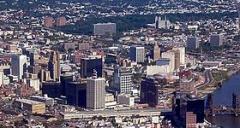

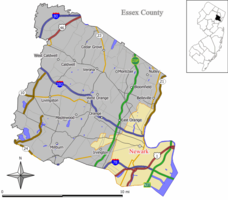
Newark ( /ËnnjuËa.Éork/) is the largest city (by population) in the U.S. state of New Jersey, and the seat of Essex County. One of the nation's major air, shipping, and rail hubs, the city had a population of 277,140 in 2010, making it the nation's 67th most-populous.
/ËnnjuËa.Éork/) is the largest city (by population) in the U.S. state of New Jersey, and the seat of Essex County. One of the nation's major air, shipping, and rail hubs, the city had a population of 277,140 in 2010, making it the nation's 67th most-populous.
Located in the heart of New Jersey's Gateway Region, Newark is the second largest city in the New York metropolitan area, approximately 8 miles (13 km) west of Manhattan. Port Newark, the major container shipping terminal in the Port of New York and New Jersey, is the largest on the East Coast. Newark Liberty International Airport was first municipal commercial airport in the United States and today one of its busiest.
Newark is headquarters to numerous corporations, such as Prudential Financial and PSEG. It is home to several universities, including Rutgers and the New Jersey Institute of Technology, and cultural and sports venues, among them the New Jersey Performing Arts Center and Prudential Center.
A culturally diverse city, Newark is divided into five geographical wards, and contains neighborhoods ranging in character from bustling urban districts to quiet suburban enclaves. Newark's Branch Brook Park is the oldest county park in the United States and is home the nation's largest collection of cherry blossom trees, which number about 4,300.
Newark was originally founded in 1666 by Connecticut Puritans led by Robert Treat from the New Haven Colony. The city saw tremendous industrial and population growth during the 19th century and early 20th century, and experienced racial tension and urban decline in the second half of the 20th century, culminated by the 1967 Newark riots. The city has experienced revitalization during the 1990s and early 21st century.
Newark was originally formed as a township on October 31, 1693, based on the Newark Tract, which was first purchased on July 11, 1667. Newark was granted a Royal Charter on April 27, 1713, and was incorporated as one of New Jersey's initial 104 townships by an act of the New Jersey Legislature on February 21, 1798. During its time as a township, portions were taken to form Springfield Township (April 14, 1794), Caldwell Township (now known as Fairfield Township (February 16, 1798), Orange Township (November 27, 1806), Bloomfield Township (March 23, 1812) and Clinton Township (April 14, 1834, remainder reabsorbed by Newark on March 5, 1902). Newark was reincorporated as a city on April 11, 1836, replacing Newark Township, based on the results of a referendum passed on March 18, 1836. The previously independent Vailsburg borough was annexed by Newark on January 1, 1905. In 1926, South Orange Township, changed its name to Maplewood. As a result of this, a portion of Maplewood known as Ivy Hill was re-annexed to Newark's Vailsburg.
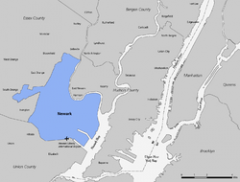
Newark is located at 40 °43 a²27 a³N 74 °10 a²21 a³W / 40.72422 °N 74.172574 °W / 40.72422; -74.172574 (40.72422,-74.172574). According to the United States Census Bureau, the city had a total area of 26.107 square miles (67.617 km2), of which, 24.187 square miles (62.644 km2) of it is land and 1.920 square miles (4.973 km2) of it (7.35%) is water. It has the third-smallest land area among the 100 most populous cities in the U.S., behind neighboring Jersey City and Hialeah, Florida. The city's altitude ranges from 0 (sea level) in the east to approximately 230 feet (70 m) above sea level in the western section of the city. Newark is essentially a large basin sloping towards the Passaic River, with a few valleys formed by meandering streams. Historically, Newark's high places have been its wealthier neighborhoods. In the 19th century and early 20th century, the wealthy congregated on the ridges of Forest Hill, High Street, and Weequahic.
Until the 20th century, the marshes on Newark Bay were difficult to develop, as the marshes were essentially wilderness, with a few dumps, warehouses, and cemeteries on their edges. During the 20th century, the Port Authority of New York and New Jersey was able to reclaim 68 acres (28 ha) of the marshland for the further expansion of Newark Airport, as well as the growth of the port lands.
Newark is surrounded by residential suburbs to the west (on the slope of the Watchung Mountains), the Passaic River and Newark Bay to the east, dense urban areas to the south and southwest, and middle-class residential suburbs and industrial areas to the north. The city is the largest in New Jersey's Gateway Region, which is said to have received its name from Newark's nickname as the "Gateway City".
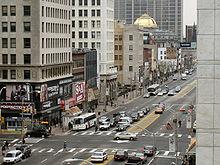
Newark is New Jersey's largest and second-most racially diverse city (after neighboring Jersey City). It is divided into five political wards, which are often used by residents to identify their place of habitation. In recent years, residents have begun to identify with specific neighborhood names instead of the larger ward appellations. Nevertheless, the wards remain relatively distinct. Industrial uses, coupled with the airport and seaport lands, are concentrated in the East and South Wards, while residential neighborhoods exist primarily in the North, Central, and West Wards.
State law requires that wards be compact and contiguous and that the largest ward may not exceed the population of the smallest by more than 10% of the average ward size. While it is possible that ward boundaries may not need to be changed if population changes in each ward were similar across the city, if the ward boundaries need to be redrawn they will be done so by a board of ward commissioners consisting of two Democrats and two Republicans appointed at the county level and the municipal clerk. Redrawing of ward lines in previous decades have shifted traditional boundaries, so that downtown currently occupies portions of the East and Central Wards. The boundaries of the wards are altered for various political and demographic reasons and sometimes gerrymandered, especially the northeastern portion of the West Ward.
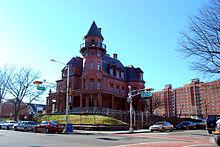
Newark's Central Ward, formerly known as the old Third Ward, contains much of the city's original history including the Lincoln Park, Military Park and the James Street Commons Historic Districts. The Ward contains the University Heights, The Coast/Lincoln Park, Government Center, Springfield/Belmont and Seventh Avenue Neighborhoods. Of these neighborhood designations only University Heights, a more recent designation for the area that was the subject of the 1968 novel Howard Street by Nathan Heard, is still in common usage. The Central Ward extends at one point as far north as 2nd Avenue. In the 19th century, the Central Ward was inhabited by Germans and other white Catholic and Christian groups. The German inhabitants were later replaced by Jews, who were then replaced by Blacks. The increased academic footprint in the University Heights neighborhood has produced gentrification, with landmark buildings undergoing renovation. Located in the Central Ward is the largest health sciences university in the nation, UMDNJ-New Jersey Medical School. It is also home to three other universities ae New Jersey Institute of Technology (NJIT), Rutgers University - Newark, and Essex County College. The Central Ward forms the present-day heart of Newark, and includes 26 public schools, two police precincts, including headquarters, four firehouses, and one branch library.
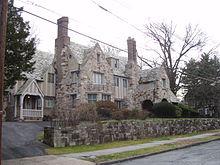
The North Ward is surrounded by Branch Brook Park. Its neighborhoods include Broadway, Mount Pleasant, Upper Roseville and the affluent Forest Hill section. Forest Hill contains the Forest Hill Historic District, which is registered on state and national historic registers, and contains many older mansions and colonial homes. A row of residential towers with security guards and secure parking line Mt. Prospect Avenue in the Forest Hill neighborhood. The North Ward has lost geographic area in recent times; its southern boundary is now significantly further north than the traditional boundary near Interstate 280. The North Ward historically had a large Italian population; demographics have transitioned to Latino in recent decades, though the ward as a whole remains ethnically diverse.
The West Ward comprises the neighborhoods of Vailsburg, Ivy Hill, West Side, Fairmount and Lower Roseville. It is home to the historic Fairmount Cemetery. The West Ward, once a predominately Irish-American, Polish, and Ukrainian neighborhood, is now home to neighborhoods composed primarily of Latinos, African Americans, Africans and Caribbean Americans. The West Ward has struggled in recent years with elevated rates of crime, particularly violent crime.
The South Ward comprises the Weequahic, Clinton Hill, Dayton, and South Broad Valley neighborhoods. The South Ward, once home to residents of predominately Jewish descent, now has ethnic neighborhoods made up primarily of African Americans and Latinos. The South Ward is represented by Council Member Ras Baraka. The city aos second-largest hospital, Newark Beth Israel Medical Center, can be found in the South Ward, as can 17 public schools, five daycare centers, three branch libraries, one police precinct, a mini precinct, and three fire houses.
Finally, the East Ward consists of Newark's Downtown commercial district, as well as the Ironbound neighborhood, where much of Newark's industry was located in the 19th century. Today, due to the enterprise of its immigrant population, the Ironbound (also known as "Down Neck") is a destination for shopping, dining, and nightlife. A historically immigrant-dominated section of the city, the Ironbound in recent decades has been termed "Little Portugal" due to its heavily Portuguese population. In addition, the East Ward has become home to Brazilians, Latin Americans, African Americans and commuters to Manhattan. Public education in the East Ward consists of East Side High School and six elementary schools. The ward is largely composed of densely packed housing, primarily large apartment buildings and rowhouses.
Newark has a humid subtropical climate (Koppen Cfa), with mild winters and hot, humid summers. Its proximity to the ocean has a moderating effect. Also, being near to the Atlantic Ocean means Newark tends to have warmer winters than cities at a similar latitude or even somewhat further south, such as Chicago, Columbus, Pittsburgh, and St. Louis. The January average is 32.3 °F (0.2 °C), and temperatures down to the 15 °F ( na9.4 °C) range are not uncommon, though they rarely fall to 0 °F ( na18 °C) or below. With a seasonal total of 26 inches (66.0 cm), snow cover does not usually remain for long. Spring in the area is of reasonable length and relatively devoid of temperature extremes. Summers are particularly hot and humid, with a July average of 77.2 °F (25.1 °C), and highs exceeding 90 °F (32 °C) on an average 25 days per year. Heat advisories are not uncommon during the summer months, particularly July and August, when temperatures can reach 100 °F (38 °C) with high humidity. The city cools off at a moderate pace during autumn.
The city receives precipitation ranging from 2.9 to 4.7 inches (74 to 119 mm) monthly, usually falling on 8 to 12 days monthly. Measurable snowfall occurs each winter, but in lesser amounts than cities in the Midwest at a similar latitude. The highest recorded temperature was 108 °F (42 °C) on July 22, 2011.
As of the 2010 United States Census, there were 277,140 people, 94,542 households, and 61,641 families residing in the city. The population density was 11,458.3 inhabitants per square mile (4,424.1 /km2). There were 109,520 housing units at an average density of 4,528.1 per square mile (1,748.3 /km2). The racial makeup of the city was 26.31% (72,914) White, 52.35% (145,085) African American, 0.61% (1,697) Native American, 1.62% (4,485) Asian, 0.04% (118) Pacific Islander, 15.22% (42,181) from other races, and 3.85% (10,660) from two or more races. Hispanic or Latino of any race were 33.83% (93,746) of the population.
There were 94,542 households out of which 33.7% had children under the age of 18 living with them, 28.0% were married couples living together, 28.9% had a female householder with no husband present, and 34.8% were non-families. 27.9% of all households were made up of individuals and 8.2% had someone living alone who was 65 years of age or older. The average household size was 2.76 and the average family size was 3.36.
In the city the age distribution of the population shows 25.6% under the age of 18, 11.9% from 18 to 24, 31.9% from 25 to 44, 22.1% from 45 to 64, and 8.6% who were 65 years of age or older. The median age was 32.3 years. For every 100 females there were 97.9 males. For every 100 females age 18 and over, there were 96.3 males.
The Census Bureau's 2006-2010 American Community Survey showed that (in 2010 inflation-adjusted dollars) median household income was $35,659 (with a margin of error of +/- $1,009) and the median family income was $41,684 (+/- $1,116). Males had a median income of $34,350 (+/- $1,015) versus $32,865 (+/- $973) for females. The per capita income for the city was $17,367 (+/- $364). About 22.0% of families and 25.0% of the population were below the poverty line, including 34.9% of those under age 18 and 22.4% of those age 65 or over.
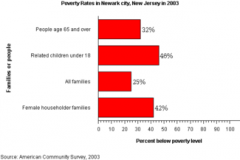
Poverty remains a consistent problem in Newark, despite its revitalization in recent years. As of 2010, roughly one-third of the city's population is impoverished. The 1967 riots resulted in White flight, a significant population loss of the city's middle class, many of them Jews, which continued from the 1970s through to the 1990s. The city lost about 130,000 residents between 1960 and 1990. The city's formerly most populous ethnic group, White, declined from 82.8% in 1950 to 26.3% by 2010.
Portions of Newark are rebounding and improving due to the abandonment and demolition of public housing projects, especially the Baxter Terrace area. Baxter Park, a mixed-use development started in July 2011 that will include 400 apartment units along with shopping and recreation space, will replace the 500 units in the original Baxter Terrace development, which was demolished starting in 2008.
Effective as of July 1, 1954, the voters of the city of Newark, by a referendum held on November 3, 1953 and under the Optional Municipal Charter Law (commonly known as the Faulkner Act), adopted the Faulkner Act (Mayor-Council) Plan C as the form of local government.
There are nine council members are elected on a nonpartisan basis at the regular municipal election or at the general election for terms of four years: one council member from each of five wards and four council members on an at-large basis. The mayor is also elected for a term of four years.
As of 2012[update], Newark's Municipal Council consists of the following members, all with a term end date of 2014.
Newark is split between the 10th and 13th Congressional districts and is part of New Jersey's 28 and 29th state legislative districts. Prior to the 2011 reapportionment following the 2010 Census, Newark had been in 27th, 28th and 29th state legislative districts. Based on the results of the 2010 Census, the New Jersey Redistricting Commission has shifted Newark into the 8th Congressional District and the 10th Congressional District, a change that will take effect in January 2013, based on the results of the November 2012 general elections, with 123,763 of the city's residents in the 8th District and 153,377 in the 10th.
New Jersey's Tenth Congressional District was represented by Donald M. Payne (D, Newark), until his death on March 6, 2012. New Jersey's Thirteenth Congressional District is represented by Albio Sires (D, West New York). New Jersey is represented in the United States Senate by Frank Lautenberg (D, Cliffside Park) and Bob Menendez (D, Hoboken).
The 28th District of the New Jersey Legislature is represented in the State Senate by Ronald Rice (D, Newark) and in the General Assembly by Ralph R. Caputo (D, Belleville) and Cleopatra Tucker (D, Newark). The 29th District of the New Jersey Legislature is represented in the State Senate by Teresa Ruiz (D, Newark) and in the General Assembly by Alberto Coutinho (D, Newark) and L. Grace Spencer (D, Newark). The Governor of New Jersey is Chris Christie (R, Mendham Township). The Lieutenant Governor of New Jersey is Kim Guadagno (R, Monmouth Beach).
Essex County's County Executive is Joseph N. DiVincenzo, Jr. The executive, along with the Board of Chosen Freeholders administer all county business. The county's Board of Chosen Freeholders consists of nine members, four elected on an at-large basis and one from each of five wards, who serve terms of office on a concurrent basis. As of 2011 Essex County's Freeholders are Freeholder President Blonnie R. Watson (at large), Freeholder Vice President Ralph R. Caputo (District 5), Rufus I. Johnson (at large), Donald Payne Jr. (at large), Patricia Sebold (at large), Samuel Gonzalez (District 1), D. Bilal Beasley (District 2), Carol Y. Clark (District 3) and Linda Lordi Cavanaugh (District 4).
On the national level, Newark leans strongly toward the Democratic Party.
As of March 23, 2011, out of a 2010 Census population of 277,140 in Newark, there were 136,785 registered voters (66.3% of the 2010 population ages 18 and over of 206,253, vs. 77.7% in all of Essex County of the 589,051 ages 18 and up) of which, 68,393 (50.0% vs. 45.9% countywide) were registered as Democrats, 3,548 (2.6% vs. 9.9% countywide) were registered as Republicans, 64,812 (47.4% vs. 44.1% countywide) were registered as Unaffiliated and there were 30 voters registered to other parties.
In the 2008 presidential election, Democrat Barack Obama received 90.8% of the vote here (77,112 ballots cast), ahead of Republican John McCain who received 7.0% of the vote (5,957 votes), with 84,901 of the city's 140,946 registered voters participating, for a turnout of 60.2% of registered voters. In the 2004 presidential election, Democrat John Kerry received 85.9% of the vote here (62,700 ballots), outpolling Republican George W. Bush, who received 12.8% (9,344), with 72,977 of 127,049 registered voters participating, for a turnout percentage of 57.4%.
In the 2009 Gubernatorial Election, Democrat Jon Corzine received 90.2% of the vote here (36,637 ballots cast), ahead of Republican Chris Christie who received 8.3% of the vote (5,957 votes), with 40,613 of the city's 134,195 registered voters (30.3%) participating.
Newark has been marred with episodes of political corruption throughout the years. Five of the previous seven Mayors of Newark have been indicted on criminal charges, including the previous three Mayors: Hugh Addonizio, Kenneth Gibson, and Sharpe James. As reported by Newsweek: "... every mayor since 1962 (except the current one, Cory Booker) has been indicted for crimes committed while in office."
Addonizio was mayor of Newark from 1962 to 1970. A son of Italian immigrants, a tailor and WWII veteran, he ran on a reform platform, defeating the incumbent, Leo Carlin, who, ironically, he characterized as corrupt and a part of the political machine of the era. During the 1967 riots, it was found that Addonizio and other city officials were taking kickbacks from city contractors. He was convicted of extortion and conspiracy in 1970, and was sentenced to ten years in federal prison.
His successor was Kenneth Gibson, the city's first African American mayor, elected in 1970. He pleaded guilty to federal tax evasion in 2002 as part of a plea agreement on fraud and bribery charges. During his tenure as Mayor in 1980, he was tried and acquitted of giving out no-show jobs by an Essex County jury.
Sharpe James, who defeated Gibson in 1986 and declined to run for a sixth term in 2006, was indicted on 33 counts of conspiracy, mail fraud, and wire fraud by a federal grand jury sitting in Newark. The grand jury charged James with spending $58,000 on city-owned credit cards for personal gain and orchestrating a scheme to sell city-owned land at below-market prices to his companion, who immediately re-sold the land to developers and gained a profit of over $500,000. James pleaded not guilty on 25 counts at his initial court appearance on July 12, 2007. On April 17, 2008, James was found guilty for his role in the conspiring to rig land sales at nine city-owned properties for personal gain. The former mayor was sentenced to serve up to 27 months in prison.
In 1996, Time magazine ranked Newark "The Most Dangerous City in the Nation." By 2007, however, the city recorded a total of 99 homicides for the year, representing a significant drop from the record of 161 murders set in 1981. The number of murders in 2008 dropped to 65, a decline of 30% from the previous year and the lowest in the city since 2002 when there were also 65 murders.
In 2011 Newark recorded 90 homicides, after experiencing 86 homicides in 2010. Overall, there was a 6% increase in crime numbers over the previous year, including a rise in carjackings for the third straight year. Along with the increase in crime, the Newark Police Department increased its recovery of illegally-owned guns in 2011 to 696, up from 278 in 2010.
After being forced to lay off 162 officers due to economic reasons in 2010, the NPD was able to rehire eight of those officers in 2012, with plans for another 17 rehires later in the year.
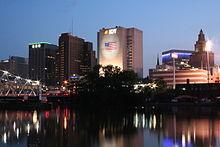
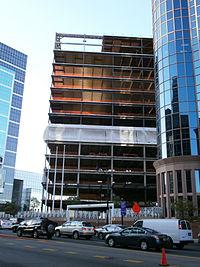
Newark is the third-largest insurance center in United States, after New York City and Hartford. The Prudential Financial and Mutual Benefit Life companies originated in the city. The former, one of the largest insurance companies in the world, is still headquartered in Newark. Many other companies are headquartered in the city, including IDT Corporation, New Jersey Transit, Public Service Enterprise Group (PSEG), Manischewitz, Horizon Blue Cross and Blue Shield of New Jersey. and Audible.com[100]
Though Newark is not the industrial colossus of the past, the city does have a considerable amount of industry. The southern portion of the Ironbound, also known as the Industrial Meadowlands, has seen many factories built since World War II, including a large Anheuser-Busch brewery. The service industry is also growing rapidly, replacing those in the manufacturing industry, which was once Newark's primary economy. In addition, transportation has become a large business in Newark, accounting for more than 17,000 jobs in 2011.[101]
The Consulate-General of Ecuador in New Jersey is located on the 4th Floor at 400 Market Street.[102] The Consulate-General of Portugal is located at the main floor of the Legal Center at One Riverfront Plaza.[103] The Vice Consulate of Italy is located in Suite 100 at 1 Gateway Center.[104] The Mission of the Central African Republic to the United Nations is located in Suite 2008 at 51 Clifton Avenue in Newark.[105]
Panasonic plans to leave its longtime North American headquarters in nearby Secaucus, New Jersey and move to a 250,000 square feet (23,000 m2) space in Newark in 2013, as part of a deal in which the company would receive over $100 million in tax incentives to add to the 800 employees it already has in New Jersey.[106]
Portions of Newark are part of an Urban Enterprise Zone. In addition to other benefits to encourage employment within the Zone, shoppers can take advantage of a reduced 3 ½% sales tax rate (versus the 7% rate charged statewide) at eligible merchants.[107]
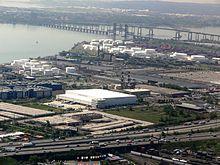
Port Newark is the part of Port Newark-Elizabeth Marine Terminal and the largest cargo facility in the Port of New York and New Jersey. Located on Newark Bay, it is run by the Port Authority of New York and New Jersey and serves as the principal container ship facility for goods entering and leaving the New York metropolitan region and the northeastern quadrant of North America. The Port moved over $100 billion in goods in 2003, making it the 15th busiest in the world at the time, but was the number one container port as recently as 1985.[108] Plans are underway for billions of dollars of improvements - larger cranes, bigger railyard facilities, deeper channels, and expanded wharves.[109]
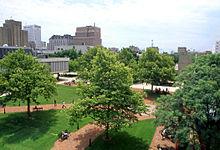
Newark is the home of the New Jersey Institute of Technology (NJIT), Rutgers-Newark, Seton Hall University School of Law, the University of Medicine and Dentistry of New Jersey (Newark Campus), Essex County College, and a Berkeley College campus. Most of Newark's academic institutions are located in the city's University Heights district. The colleges and universities have worked together to help revitalize the area, which serves more than 40,000 students and faculty.[110]
As of the 2006-2010 American Community Survey, 16.0% of Newark residents ages 25 and over had never attended high school and 15.9% didn't graduate, while 68.1% had at least graduated from high school, including the 12.3% who had earned a bachelor's degree or higher. The total school enrollment in Newark city was 75,025 in the 2006-2010 ACS, with pre-primary school enrollment of 10,560, elementary or high school enrollment of 46,691 and college enrollment of 17,774.
The Newark Public Schools, a state-operated school district, is the largest school system in New Jersey. The district is one of 31 Abbott districts statewide,[111] which are now referred to as "SDA Districts" based on the requirement for the state to cover all costs for school building and renovation projects in these districts under the supervision of the New Jersey Schools Development Authority.[112][113] As of the 2009-10 school year, the district's 75 schools had an enrollment of 39,443 students and 2,685 classroom teachers (on an FTE basis), for a student aeteacher ratio of 14.69.[114]
The city's public schools are among the lowest-performing in the state, leading to a take over by the state government in 1995 with the intention of improvement. The school district continues to struggle with low high school graduation rates and low standardized test scores. A notable exception to this was Science Park High School, which was the 69th-ranked public high school in New Jersey out of 322 schools statewide, in New Jersey Monthly magazine's September 2010 cover story on the state's "Top Public High Schools", after being ranked 50th in 2008 out of 316 schools. Technology High School has a GreatSchools rating of 9/10 was ranked 165th in New Jersey Monthly's 2010 rankings. Newark high schools ranked in the bottom 10% of New Jersey Monthly'ss 2010 list include Central (274th), East Side (293rd), Newark Vocational (304th), Weequahic (310th), Barringer (311th), Malcolm X Shabazz (314th) and West Side (319th).[115] Facebook co-founder Mark Zuckerberg donated a challenge grant of $100 million to the district in 2010, choosing Newark because he stated he believed in Mayor Cory Booker and Governor Chris Christie's abilities.[116]
Charter schools in Newark include the Robert Treat Academy Charter School, a National Blue Ribbon School drawing students from all over Newark. It remains one of the top performing K-8 schools in New Jersey based on standardized test scores.[117] University Heights Charter School is another charter school, serving children in grades K-5, recognized as a 2011 Epic Silver Gain School.[118] Gray Charter School, like Robert Treat, also won a Blue Ribbon Award.[119] Also, Newark Collegiate Academy (NCA) opened in August 2007 and currently serves 420 students in grades 9-12. It will ultimately serve over 570 students, mostly matriculating from other charter schools in the area.[120]
The city hosts three high schools as part of the Roman Catholic Archdiocese of Newark. The coeducational Christ The King Prep, founded in 2007, is part of the Cristo Rey Community; Saint Benedict's Preparatory School is an all-boys Roman Catholic high school founded in 1868 and conducted by the Benedictine monks of Newark Abbey, whose campus has grown to encompass both sides of MLK Jr. Blvd. near Market Street and includes a dormitory for boarding students; and Saint Vincent Academy, is an all-girls Roman Catholic high school founded and sponsored by the Sisters of Charity of Saint Elizabeth and operated continuously since 1869.[121]
Link Community School is a non-denominational coeducational day school located serving approximately 128 students in seventh and eighth grades. The Newark Boys Chorus School was founded in the 1960s.[122] The University Heights Charter School teaches 160 students in grades K-5.
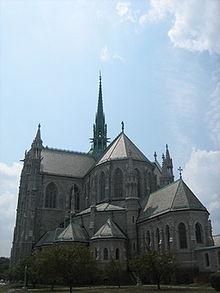
There are several notable Beaux-Arts buildings, such as the Veterans' Administration building, the Newark Museum, the Newark Public Library, and the Cass Gilbert-designed Essex County Courthouse. Notable Art Deco buildings include several 1930s era skyscrapers, such as the National Newark Building and Eleven 80, the restored Newark Penn Station, and Arts High School. Gothic architecture can be found at the Cathedral of the Sacred Heart by Branch Brook Park, which is one of the largest gothic cathedrals in the United States. It is rumored to have as much stained glass as the Cathedral of Chartres. Newark also has two public sculpture works by Gutzon Borglum ae Wars of America in Military Park and Seated Lincoln in front of the Essex County Courthouse. Moorish Revival buildings include Newark Symphony Hall and the Prince Street Synagogue, one of the oldest synagogue buildings in New Jersey.[123]
Newark is site of the New Jersey Performing Arts Center, located near Military Park, which since its opening in 1997 has become the home of the New Jersey Symphony Orchestra and the New Jersey State Opera, and has developed into one the most visited in the United States. NJPAC is involved in the construction of One Theater Square, a mixed-use skyscraper in the heart of the cultural district that is planned to include the city's tallest building. The center's programs of national and international music, dance, and theater make it the nation's sixth-largest performing arts center, attracting over 400,000 visitors each year.[124]
Prior to the opening of the performing arts center, Newark Symphony Hall was home to the New Jersey Symphony, the New Jersey State Opera, and the Garden State Ballet, which stills maintains an academy there.[125] The 1925 neo-classic building, originally built by the Shriners, has three performance spaces, including the main concert named in honor of famous Newarker Sarah Vaughn, offering rhythm and blues, rap, hip-hop, and gospel music concerts, and is part of the modern day Chitlin' circuit.[126]
The Newark Boys Chorus, founded in 1966, performs regularly in the city. The Arican Globe Theater Works presents a new works seasonally. The biennial Geraldine R. Dodge Poetry Festival took place in Newark for the first time in 2010.[127][128]
Venues at the universities in the city are also used to present professional and semi-professional theater, dance, and music. Since its opening, the Prudential Center in 2007 has presented Diana Ross, Katy Perry, Lady Gaga, Britney Spears, The Eagles, Hannah Montana/Miley Cyrus, Spice Girls, Jonas Brothers, Metro Station, Metallica, Alicia Keys, Demi Lovato, David Archuleta, Taylor Swift and American Idol Live!, among others. Bon Jovi performed a series of ten concerts to mark the venue's opening.[129]
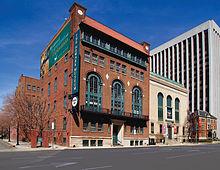
The Newark Museum is the largest in New Jersey. Highlights of its collection include American and Tibetan art. The museum also contains science galleries, a planetarium, a gallery for children's exhibits, a fire museum, a sculpture garden and an 18th century schoolhouse. Also part of the museum is the historic John Ballantine House, a restored Victorian mansion which is a National Historic Landmark. The museum co-sponsors the Newark Black Film Festival, which has premiered numerous films since its founding in 1974.[130]
The city is also home to the New Jersey Historical Society, which has rotating exhibits on New Jersey and Newark. The Newark Public Library, the state's largest system with 11 locations, also produces a series of historical exhibits. The library houses more than a million volumes and has frequent exhibits on a variety of topics, many featuring items from its Fine Print and Special Collections.[131]
In February 2004, plans were announced for a new Smithsonian Institution-affiliated Museum of African American Music to be built in the city's Coast/Lincoln Park neighborhood. The museum will be dedicated to black musical styles, from gospel to rap. The new museum will incorporate the facade of the old South Park Presbyterian Church, where Abraham Lincoln once spoke.[132]
On December 9, 2007 the Jewish Museum of New Jersey,[133] located at 145 Broadway in the Broadway neighborhood held its grand opening. The museum is dedicated to the cultural heritage of New Jersey aos Jewish people. The museum is housed at Ahavas Sholom,[134] the last continually operating synagogue in Newark. By the 1950s there were 50 synagogues in Newark serving a Jewish population of 70,000 to 80,000, once the sixth-largest Jewish community in the United States.[135][136]
Newark is also home to numerous art galleries including Aljira, a Center for Contemporary Art, City Without Walls, Gallery Aferro, Rupert Ravens Contemporary, Sumei Arts Center,[137] and the Paul Robeson Galleries[138] at Rutgers-Newark.
In April 2010, plans were announced for a new Children's Museum of New Jersey to be created across from Newark Penn Station.[139]
There are several festivals and parades held annually or bi-annually including the Cherry Blossom Festival (April) in Branch Brook Park, the Lincoln Park Music Festival (July) at Lincoln Park, the Newark Black Film Festival (Summer), the Portugal Day Festival (June) in The Ironbound and the McDonald's Gospelfest (June) at Prudential Center, Geraldine R. Dodge Poetry Festival (October) (biennale) at various venues and the city-wide Open Doors (October)[140]
While there have been many sports teams in Newark proper, it has spent much of its history without an MLB, NBA, NHL, or NFL team actually located in the city itself. The Meadowlands Sports Complex which hosts NYC metropolitan area teams, is less than 10 miles (16 km) from downtown and the Prudential Center.[141]
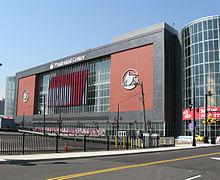
The New Jersey Devils of the National Hockey League are the only professional sports team to play within the city limits of Newark. In 2007, the Devils moved from the Continental Airlines Arena in East Rutherford to the Prudential Center in downtown Newark, an arena jointly financed by the team and the city.[142]
In Harrison, across the Passaic River from Newark's Ironbound neighborhood, the Red Bull Arena serves as the home stadium for Major League Soccer's New York Red Bulls. A pedestrian bridge linking the two cities at the Riverbank Park/Minish Park is planned as part of the Passaic River promenade.[143]
Although Newark has had a rich history in baseball and currently has a minor league team, the city has never had a Major League Baseball team. Newark had eight teams in the National Association of Base Ball Players, including the Newark Eurekas and the Newark Adriatics.[144] Newark was then home to the Newark Indians of the International League and then to the Newark Peppers of the Federal League, sometimes nicknamed the Newfeds. The city was also hosted the Negro League's Newark Dodgers and Newark Eagles, the latter for whom the Bears and Eagles Riverfront Stadium is partially named.[145] The current Newark minor league team, the revived Newark Bears, play at Bears and Eagles Riverfront Stadium, a stop on the Newark Light Rail. The Bears are part of the independent Atlantic League, which also includes the Somerset Patriots in Bridgewater Township and the Camden Riversharks in Camden.[146]
Newark gained an NBA tenant for the first time when the then-New Jersey Nets moved to the city in 2010, though the move was temporary as the team completed construction of its own arena, the Barclays Center in Brooklyn, New York for the 2012 ae13 season.[147] The New York Liberty of the Women's National Basketball Association (WNBA) will have its home court at Newark's Prudential Center for three seasons until renovations of Madison Square Garden are completed in 2013.[148]
A professional basketball team in the American Basketball Association, the Newark Express was introduced to the city in 2005. The team formerly played their home at Essex County College and Drew University in Madison and now play at East Orange Campus High School.[149]
Newark had a team which competed in the first American Football League in 1926, the Newark Bears. A short-lived NFL franchise named the Newark Tornadoes folded in 1930. In 1937, the AFL team the Orange Tornadoes moved to Newark, becoming the Newark Tornadoes which competed in the AA's Southern Division. In 1939, the Tornadoes were purchased by Chicago Bears owner George Halas as a farm team, eventually moving to Akron, Ohio.[150] In 1946, they were replaced by the Newark Bombers, which in 1947 moved to Bloomfield, New Jersey and became the Bloomfield Cardinals.
Newark does not have any major television network affiliates due to its proximity to New York City. However, WNET, a flagship station of the Public Broadcasting Service, and Spanish-language WFUT-TV, a TeleFutura owned-and-operated station, are licensed to Newark. The state's leading newspaper, The Star-Ledger, owned by Advance Publications, is based in Newark. Radio Station WJZ (now WABC (AM)) made its first broadcast in 1921 from the Westinghouse plant near Lackawanna Station. It moved to New York City in the 1920s. Pioneer radio station WOR AM was originally licensed to and broadcast from the Bamberger's Department Store in Newark. Radio Station WNEW-AM (now WBBR) was founded in Newark in 1934. It later moved to New York City. In addition, WBGO, a National Public Radio affiliate that reaches New York City with a format of standard and contemporary jazz, is located in downtown Newark. WNSW AM-1430 (formerly WNJR) and WQXR (which was formerly WHBI and later WCAA) 105.9 FM are also licensed to Newark.[151]
There have been several film and TV productions depicting life in Newark. Life of Crime, was originally produced in 1988 and was followed by a 1998 sequel.[152] New Jersey Drive, a 1995 film about the city when it was considered the "car theft capital of the world".[153] Street Fight is an Academy Award-nominated documentary film which covered the 2002 mayoral election between incumbent Sharpe James and challenger Cory Booker. In 2009, the Sundance Channel aired Brick City, a five-part television documentary about Newark, focusing on the community's attempt to become a better and safer place to live, against a history of nearly a half century of violence, poverty and official corruption. The second season premiered January 30, 2011.[154] Revolution '67 is an award winning documentary which examines the causes and events of the 1967 Newark riots. The HBO television series The Sopranos filmed many of its scenes in Newark, and is partially based on the life of Newark mobster Richard Boiardo.[155][156]
Numerous movies, televison programs, and music videos have have been shot in Newark, it's period architecture and its streetscape seen as an ideal "urban setting". In 2011, the city created the Newark Office of Film and Televsion in order to promote the making of media productions.[157][158] Some months earlier the Ironbound film and Televisin studio, the only, "stay and shoot" facility in the metro area opened, it's first production being Bar Karma. [159] In 2012 the city hosted the seventh season of the reality show competition America's Got Talent.[160]
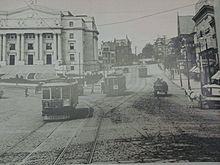
The Morris Canal, stretching 102 miles (164 km) to Newark from Phillipsburg on the Delaware River was completed in 1831 and allowed coal and other industrial and agricultural products from Pennsylvania to be transported cheaply and efficiently to the New York City area.[161] The canal's completion led to increased settlement in Newark, vastly increasing the population for years to come. As the city came to be more and more congested, further means of transportation were sought; eventually leading to horse drawn trolleys which eventually became electric trolleys that ran down the main streets of downtown Newark including Broad Street and up Market Street near the courthouse. The trolley cars did not last long as the personal motor vehicle quickly gained popularity and slowly made the trolley system seem like a burden.[162] The Morris Canal also saw its days come to an end, only to be more recently used by the Newark City Subway, now known as the Newark Light Rail. Even today, many of the subway stations still portray the Canal in its original state in the form of mosaic works.
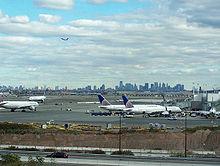
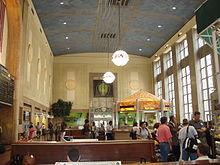
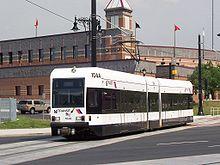
Newark is a hub of air, road, rail, and ship traffic, making it a significant gateway into the New York metropolitan area and the northeastern United States.[163] Newark Liberty International Airport, the second-busiest airport in the New York region and the 14th-busiest in the United States (in terms of passenger traffic),[164] had 403,429 plane movements, transported 33,107,041 passengers, 860,845 tons of cargo and processed 82,479 tons of airmail in 2010.[165] Newark Airport was the New York City area's first commercial airport, opened in 1928 on land reclaimed by the Port Authority. Just east of the airport lies Port Newark, the fifteenth-busiest port in the world and the largest container port on the East Coast of the United States. In 2003, the port moved over $100 billion in goods.[166]
Newark is served by numerous highways including the New Jersey Turnpike (Interstate 95), Interstate 280, Interstate 78, the Garden State Parkway, U.S. Route 1/9, U.S. Route 22, and Route 21. Newark is connected to the Holland Tunnel and Lower Manhattan by the Pulaski Skyway, spanning both the Passaic and Hackensack Rivers., which was first constructed in 1938 and will be undergoing a $900 million renovation project.[167]
Local streets in Newark conform to a quasi-grid form, with major streets radiating outward (like spokes on a wheel) from the downtown area. Some major roads in the city are named after the towns to which they lead, including South Orange Avenue, Springfield Avenue, and Bloomfield Avenue, as well as Broadway, which had been renamed from Belleville Avenue.[168]
Newark is second in the U.S. to New York City in the proportion of households without an automobile, and is extensively served by mass transit. Newark Penn Station, situated just east of downtown, is the city's major train station, connecting the interurban PATH system (which links Newark to Manhattan) with three New Jersey Transit commuter rail lines and Amtrak service to Philadelphia and Washington, D.C. It was designed by McKim, Mead & White and completed in 1935. Only one mile north, the Newark Broad Street Station is served by two commuter rail lines. The two train stations are linked by the Newark Light Rail system, which also provides services from Newark Penn Station to Newark's northern communities and into the neighboring towns of Belleville and Bloomfield. Built in the bed of the Morris Canal, the light rail cars run underground in Newark's downtown area. The city's third train station, Newark Liberty International Airport, connects the Northeast Corridor and North Jersey Coast Line to the airport via AirTrain Newark. Bus service in Newark is provided by New Jersey Transit, CoachUSA contract operators and DeCamp in North Newark.[169]
Newark is served by New Jersey Transit bus routes 1, 5, 11, 13, 21, 25, 27, 28, 29, 34, 37, 39, 40, 41, 42, 43, 59, 62, 65, 66, 67, 70, 71, 72, 73, 74, 75, 76, 78, 79, 90, 92, 93, 94, 96, 99, 107, and 108. Bus route 308 is an express bus route to Six Flags Great Adventure from Newark Penn Station while 319 is an express service to Atlantic City.[170]
The go bus 25 and go bus 28 are bus rapid transit lines through the city to Irvington, Bloomfield, and Newark Liberty.[171][172]
Newark is home to four hospitals. University Hospital is the principal teaching hospital of the UMDNJ-New Jersey Medical School and is the busiest Level I trauma center in the state.[173] UMDNJ also provides emergency medical services to the city. Newark Beth Israel Medical Center is the largest hospital in the city and is a part of Barnabas Health, the state's largest system of hospital and health care facilities.[174] Beth Israel is also one of the oldest hospitals in the city, dating back to 1901. This 669-bed regional facility is also home to the Children's Hospital of New Jersey. Catholic Health East operates Street Michael's Medical Center. Hospitals which have been closed in recent years include the Street James Hospital, Columbus Hospital, Mount Carmel Guild Hospital and the United Hospitals Medical Center.[175][176][177]
UMDNJ Staffs a full-time EMS system off of Cabinet Street behind the old Martland hospital building. The department operates a 24/7 fleet of 10 BLS units staffed with two EMTs, 5 ALS units staffed with two paramedics (units cover Port Newark, EWR, and most of Essex County), one Heavy Rescue unit, one Critical Care unit staffed with one paramedic and one nurse, and two Field Supervisors. University Hospital EMS (UH-EMS) carries special operations equipment that can cover any sepctrum of disaster. The fast-paced EMS system is the busiest system per unit in the nation. On average, a BLS unit may be sent to 20-25 dispatches in a 12-hour shift. UMDNJ also operates the Regional Emergency Medical Communications Service (REMCS), the regional dispatch center for UH-EMS as well as state-wide disaster management and the JEMSTAR medivac program, managing inter-facility and on-scene medivac requests to the state's aircraft (Northstar, Southstar, MEDIVAC1, Monoc Air 1, Atlantic Air 1, Atlantic Air 2). Staffed at all times by six EMD certified dispatchers, REMCS also dispatches the Orange, Maplewood, and Irvington NJ fire departments. The EMS system in Newark handles upwards of 125,000 requests for service annually.[178]
The city of Newark is protected 24/7, 365 by the 700 full-time, paid firefighters of the city of Newark Fire Department(NFD). Founded in 1863, the Newark Fire Department operates out of 16 Fire Stations, located throughout the city in 3 Battalions. The NFD also operates and maintains a front line fire apparatus fleet of 15 Engines, 8 Ladders, 1 Rescue, 4 Haz-Mat. Units, a Foam Unit, a Mobile Command Unit, an Air Unit, a Fireboat, and numerous other special, support, and reserve units. The Newark Fire Department responds to around 45,000 emergency calls annually. In 2006, of that 45,000, the NFD respond to 2681 fire and hazardous condition calls.[180]
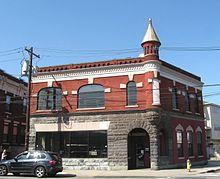
On October 1, 2010, the NFD removed Battalion 1 from service and distributed the command of its Fire Stations and Companies over the remaining 3 Battalions. Also, Engine 12, Engine 16, and Ladder 1 were disbanded from service.[181][182][183]
Up to 2010, the firehouse located at 191 Orange Street was home to Ladder 1, Rescue 1, and Haz-Mat. 1. Currently, it no longer houses active fire companies, however it is the headquarters of the department's Special Operations Division and houses Haz-Mat. 2, the Haz-Mat. Spill Unit, the Haz-Mat. Decontamination Unit, the Dive Unit, the Foam Unit, the Mobile Command Unit, and many other Special Operations Units. Like other stations in the city, it also houses a fleet of reserve/spare fire apparatuses. Also, the Special Services and Fire Alarm Line Divisions are located at 56 Prospect Street (former quarters of Engine 5) in the North Ironbound neighborhood.[184]
Newark has 11 sister cities, as designated by Sister Cities International:[185]

Word Count: 8273






